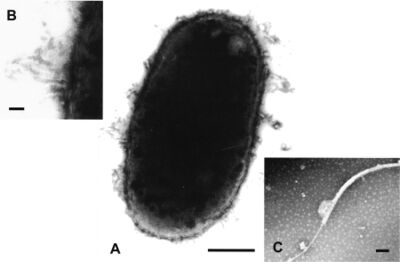Vibrio fluvialis
Classification
Bacteria; Pseudomonadota; Gammaproteobacteria; Vibrionales; Vibrionaceae
Species
|
NCBI: [1] |
V. fluvialis
Halophilic Vibrio species
Description and Significance
Vibrio fluvialis was first announced in 1977 with its original name of group F and group EF- 6 vibrios (Zheng et al., 2022). Researchers have isolated V. fluvialis from the stool of various infected patients with acute diarrheal illnesses, gastroenteritis, and extraintestinal infections. Vibrio fluvialis is a worldwide microbe found predominantly in coastal environments; seas, estuaries, salty waters (Ramamurthy et al., 2014). The microbe contains curved cell morphology as the cell rod has a straight to curved ratio. V. fluvialis uses polar flagellar motility to propel itself in liquid at high speeds of 100,000 rpm. This gram-negative species are short and slim anaerobes that form S shapes and spirals (Zheng et al.,2017).
According to the U.S. Centers for Disease Control and Prevention, vibrio infections have tripled from 1996- 2010. Vibrio fluvialis is less common than other vibrio species, however; it is easily pathogenically transmitted through ingestion of contaminated raw shellfish and over exposure to brackish waters (The Pew Charitable Trusts, 2013). V. fluvialis is important to be known of as it is one of the top five leading causes of water-borne infections in America.
Genome Structure
The genome structure of V. fluvialis consists of two circular chromosomes (Okada et al., 2005). In detail, together the two chromosomes have more or less than 4,000 protein coding genes, 60-100 tRNA, and 5-30 rRNA. Sequencing of many strands of Vibrio fluvialis determined the genome size to range from 4.50 Mb to 5.50 Mb (Zheng et al.,2017). An abundant amount of virulence factors and antimicrobial resistance genes were identified as the reason for high levels of homologous recombination. The evolution of pathogenesis in Vibrio fluvialis relies on its gene structure. V. fluvialis contains different strains and gene structure correlating to different areas in the world.
Cell Structure, Metabolism and Life Cycle
Similar to many bacterium in the vibrio species, V. fluvialis is microbiologically expressed as a gram-negative, comma-shaped, anaerobic bacterium cell. This highly motile pathogen contains one to three flagella to propel itself around its host (Igbinosa and Okoh, 2010). It was reported to test positive for oxidase and cannot form spores. On host HeLa cells, this microbe possesses El Tor-like hemolysin and performs cytotoxic and cell-vacuolating activity. The cell structure contains genes that encode proteins including eut operon. Eut operon utilizes ethanolamine (EA), a small molecule found in diets of the host to act as an energy source.
Ecology and Pathogenesis
This pathogenic species thrives in warmer salt waters of 7% NaCl. The temperature of 23 degrees Celsius contributes to the growth of V. fluvialis. This water-borne pathogen and it's host inhabits the negative interaction of amensalism. V. fluvialis produces compounds that negatively effect the host, while left unphased. The contribution to the environment consists of pathogenesis through seafood hosts and consumption by humans.
Pathogenesis identification in V. fluvialis is a complex discovery as the organism’s biochemical composition is notably similar to those of the vibrio species (Klontz and Desenclos, 1990). The cell physiology of this microbe allows survival with starvation and environmental stress for long periods of time. V. fluvialis can be found in humans as a sole pathogen and as a co-pathogen with other present enteric bacterium. It has been confirmed that V. fluvialis is responsible for symptoms of vomiting, abdominal pain, moderate to severe dehydration, high fevers, and diarrhea (Lockwood et al., 1981). This microorganism causes disease in many different ways with the contribution of enterotoxins, cytotoxins, hemolysin, and quorum sensing systems (Chakraborty et al., 2005). V. fluvialis is an enteric pathogen that secrete pore-forming toxins and are important factors of virulence in the host. The cytotoxic responses produced, destroy and damage the gastrointestinal tract of their host, leading to abdominal symptoms.
References
Chakraborty, Rupa, et al. “Cytotoxic and Cell Vacuolating Activity of Vibrio Fluvialis Isolated from Paediatric Patients with Diarrhoea.” Journal of Medical Microbiology, Microbiology Society, 1 Aug. 2005, https://www.microbiologyresearch.org/content/journal/jmm/10.1099/jmm.0.45820-0.
Igbinosa, E. O., & Okoh, A. I. (2010, October). Vibrio fluvialis: An unusual enteric pathogen of increasing Public Health Concern. International journal of environmental research and public health. Retrieved November 16, 2022, from https://www.ncbi.nlm.nih.gov/pmc/articles/PMC2996184/
Klontz, K. C., & Descenlos S, J. — C. A. (1990). Clinical and epidemiological features of sporadic infections with vibrio fluvialis in florida, usa. Journal of Diarrhoel Diseases Research, vol. 8 no. 1⁄2, pg. 24-26. http://www.jstor.org/stable/23498047
Libretexts. (2021, January 3). 15.17f: Noncholera Vibrios. Biology LibreTexts. Retrieved November 16, 2022, from https://bio.libretexts.org/Bookshelves/Microbiology/Book%3A_Microbiology_(Boundless)/15%3A_Diseases/15.17%3A_Bacterial_Diseases_of_the_Digestive_System/15.17F%3A_Noncholera_Vibrios
Lockwood, Donald E, et al. “Detection of Toxins Produced by Vibrio Fluvialis.” American Society for Microbiology Journals, 27 July 1981, https://journals.asm.org/doi/10.1128/iai.35.2.702-708.1982.
Mandal, S., & Mandal, M. (2014, April 14). Vibrio: Vibrio cholerae. Encyclopedia of Food Microbiology (Second Edition). Retrieved November 16, 2022, from https://www.sciencedirect.com/science/article/pii/B9780123847300003463
Okada, K., Iida, T., Kita-Tsukamoto, K., & Honda, T. (2005, January). Vibrios commonly possess two chromosomes. Journal of bacteriology. Retrieved November 16, 2022, from https://www.ncbi.nlm.nih.gov/pmc/articles/PMC543535/#r46
The Pew Charitable Trusts. (2013, May 28). Vibrio infections in the U.S. increased significantly in recent years. The Pew Charitable Trusts. Retrieved November 16, 2022, from https://www.pewtrusts.org/en/research-and-analysis/fact-sheets/2013/05/28/vibrio-infections-in-the-us-increased-significantly-in-recent-years
Ramamurthy, T., Chowdhury, G., Pazhani, G. P., & Shinoda, S. (2014, March 7). Vibrio fluvialis: An emerging human pathogen. Frontiers in microbiology. Retrieved November 16, 2022, from https://www.ncbi.nlm.nih.gov/pmc/articles/PMC3948065/
Zheng, B., Jiang, X., Cheng, H., Guo, L., Zhang, J., Xu, H., Yu, X., Huang, C., Ji, J., Ying, C., Feng, Y., Xiao, Y., & Li, L. (2017, September 19). Genome characterization of two bile-isolated vibrio fluvialis strains: An insight into pathogenicity and bile salt adaption. Nature News. Retrieved November 16, 2022, from https://www.nature.com/articles/s41598-017-12304-8#:~:text=General%20genome%20features&text=The%20two%20chromosomes%20contain%204%2C395,49.9%25%20(207%20contigs)
Zheng, H., Huang, Y., Liu, P., Yan, L., Zhou, Y., Yang, C., Wu, Y., Qin, J., Guo, Y., Pei, X., Guo, Y., Cui, Y., & Liang, W. (2022, February). Population genomics of the food-borne pathogen vibrio fluvialis reveals lineage associated pathogenicity-related genetic elements. Microbial genomics. Retrieved November 16, 2022, from https://www.ncbi.nlm.nih.gov/pmc/articles/PMC8942032/
Author
Page authored by Alexis Duran, student of Prof. Bradley Tolar at UNC Wilmington.

